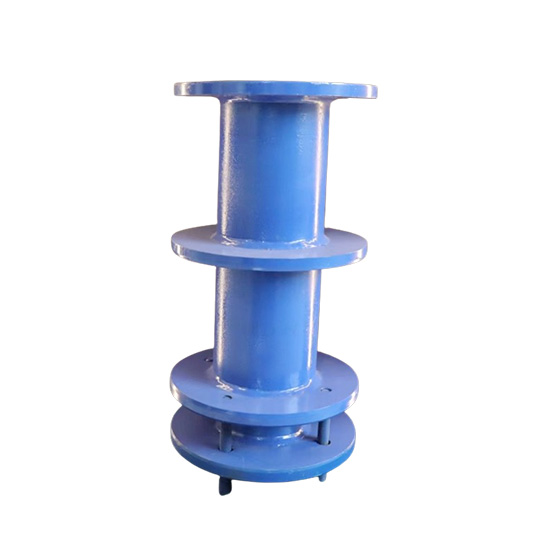
Flexible waterproof conduit
Flexible waterproof conduit is a waterproof sealing device used for pipeline penetration through walls, mainly used in buildings and structures with strict waterproof requirements, such as water tanks, water towers, basements, etc. Here is a detailed introduction:
Structural characteristics
Composition: Flexible waterproof sleeves are usually composed of steel pipes, wing rings, retaining rings, rubber sealing rings, nuts, and other components. The steel pipe serves as the main body of the casing, used to protect the pipeline and provide determined strength and support; Wing ring is a circular metal plate welded onto steel pipes, mainly used to increase the contact area with the wall and improve waterproof performance; The retaining ring is used to fix the rubber sealing ring and prevent displacement during use; Rubber sealing ring is a key component for achieving waterproof function, with good elasticity and sealing performance, and can adapt to slight displacement and deformation of pipelines; Nuts are used to secure waterproof sleeves to walls or other structures.
Sealing principle: By the elastic deformation of the rubber sealing ring, it is tightly adhered between the pipeline and the sleeve, forming a sealing barrier to prevent water from leaking from the gap between the pipeline and the wall. At the same time, the sealing treatment between the wing ring and the wall, as well as the structural design of the entire sleeve, further enhance the waterproof effect.
advantage
Good flexibility: able to adapt to the expansion and displacement of pipelines caused by temperature changes, earthquakes, and other factors, avoiding damage to the waterproof layer caused by pipeline deformation and protecting the excellent waterproof performance.
Excellent sealing performance: Rubber sealing rings have good water resistance, aging resistance, and sealing performance, which can effectively prevent water leakage and confirm the waterproof effect of buildings or structures.
Easy installation: The structure of flexible waterproof conduit is relatively simple, and the installation process is relatively convenient. It can be installed before or after pipeline installation, reducing construction difficulty and workload.
Wide applicability: It can be used for pipes of various materials and specifications, such as steel pipes, cast iron pipes, plastic pipes, etc. It is also suitable for different types of wall structures, such as brick walls, concrete walls, etc.
Application scenarios
Building water supply and drainage system: used in areas with water such as basements, bathrooms, kitchens, etc. of buildings, for the penetration of water supply and drainage pipes through walls, to prevent water leakage from the walls into indoor or outdoor spaces and protect the waterproof performance of buildings.
Sewage treatment plant: used for wall sealing of pipelines in facilities such as water tanks and pump rooms to prevent sewage leakage, protect the environment, and ensure the safety of buildings.
Water conservancy engineering: used in water conservancy projects such as reservoirs, dams, and canals, for various pipeline penetrations through walls or dams, to protect the waterproof performance of the project and prevent water leakage from damaging the engineering structure.
Industrial buildings: used in chemical, petroleum, metallurgical and other industrial plants for pipeline penetrations with waterproof requirements, such as industrial wastewater discharge pipelines, process pipelines, etc., to ensure the safety of waterproofing during the production process.
Installation precautions
Pre installation inspection: Before installing the flexible waterproof sleeve, carefully check the specifications, dimensions, materials, and whether all components of the sleeve are intact, and whether the rubber sealing ring is deformed or damaged. At the same time, it is necessary to verify the specifications and installation position of the pipeline, and confirm that the casing matches the pipeline.
Installation position: The waterproof sleeve should be installed at the designated location in the design, ensuring that its center coincides with the center of the pipeline and is perpendicular to the wall. During installation, it is important to avoid external impact and compression on the casing to prevent deformation or damage.
Pipeline connection: After passing the pipeline through the waterproof sleeve, sealing treatment should be carried out between the pipeline and the sleeve. Generally, first wrap a few circles of hemp or asbestos rope around the pipeline, then fill the gaps tightly with sealant or sealant, and then install rubber sealing rings and retaining rings, and tighten the nuts.
Wall construction: During wall construction, attention should be paid to protecting the waterproof casing to avoid damage to the casing during concrete pouring. At the same time, it is necessary to confirm that the gap between the wall and the casing is tightly filled, and waterproof mortar or other sealing materials can be used for sealing to protect the waterproof effect.
Follow up inspection: After the installation of the pipeline system is completed, multiple inspections should be conducted on the flexible waterproof sleeve to check whether the rubber sealing ring is installed in place, whether the nut is tightened, and whether there is any leakage between the pipeline and the sleeve. If any problems are found, they should be rectified in a timely manner to confirm the normal use of the waterproof casing.
Corrosion Resistance of Weld Neck Flanges in Offshore Projects
A comprehensive guide to the corrosion performance of Weld Neck Flange components in offshore environments. Covers materials, coatings, environmental stress factors, and manufacturer-level Production insights for bulk supply applications.
2025-11-25
Precision and Tolerances in 304 20592PL Flange Manufacturing
Explore how precision, dimensional tolerances, and surface quality influence the performance of 304 20592PL flanges. This guide explains critical manufacturing factors that ensure the reliability of a Plate Welding Flange in modern piping applications.
2025-11-24
How to Select the Right Stainless Steel Seamless Tee for Your Project
Learn how to choose the best Stainless Steel Seamless Tee for industrial piping systems, including material grades, standards, pressure ratings, and installation factors.
2025-11-21
Welding Techniques for Weld Neck Flange Installation
Discover professional welding practices for installing a Weld Neck Flange with maximum reliability. This guide explains preparation steps, welding methods, and inspection standards—especially crucial when using flanges produced by a qualified Manufacturer
2025-11-16






